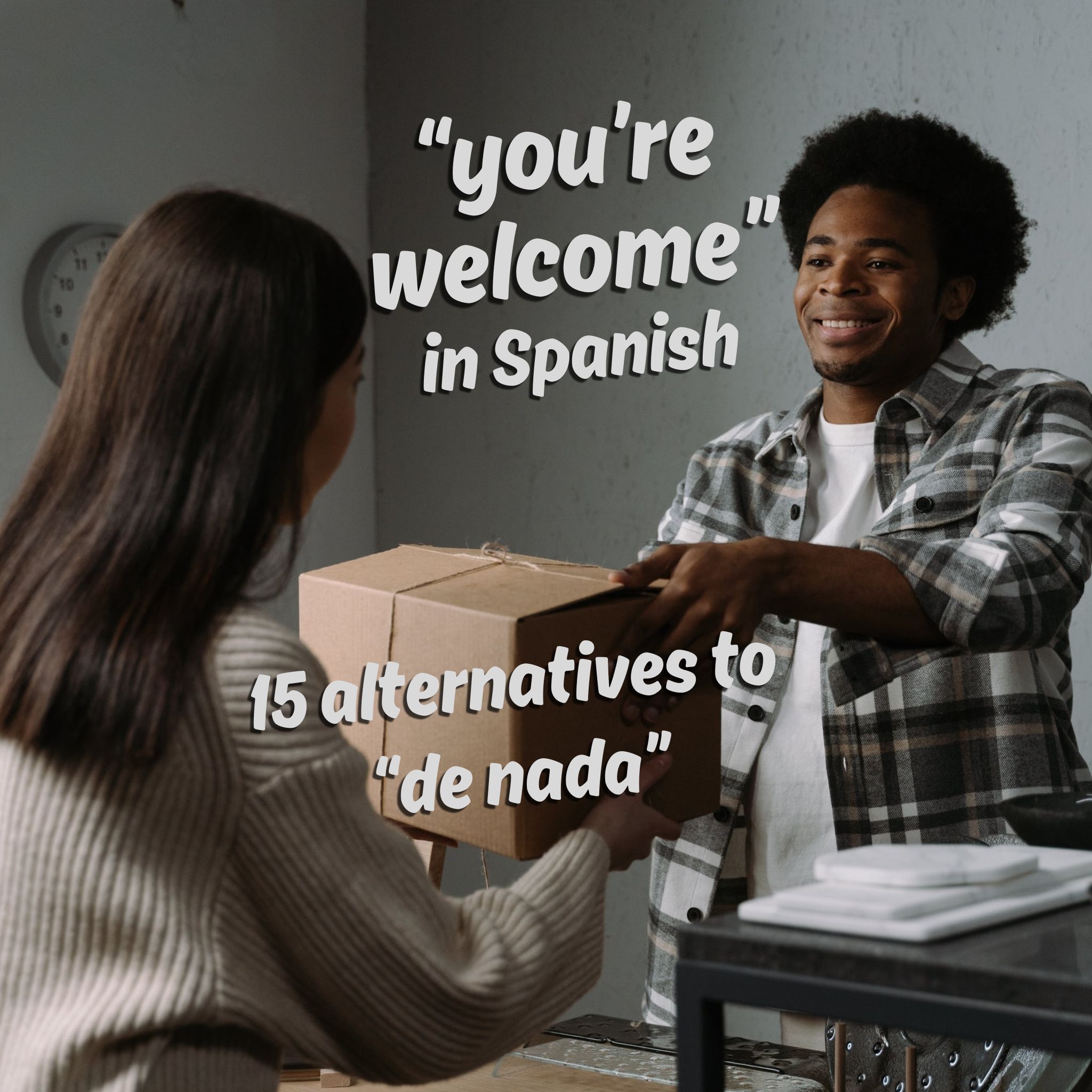You’re Welcome in Spanish: 15 unique expressions for any situation

Get our free email course, Shortcut to Conversational.
Have conversations faster, understand people when they speak fast, and other tested tips to learn faster.
More info“No problem!” “No worries!” “My pleasure!” Just like in English, we have many different expressions to say you’re welcome in Spanish.
If you’re like most Spanish students, then you probably learned ¡de nada! early on, and stuck with this easy Spanish you’re welcome expression.
Of course there’s nothing wrong with that, since it’s probably the most common you’re welcome Spanish speakers use. In today’s post, however, we’ll be giving you a few alternative ways to express the same sentiment.
So whether you’re making small talk with a friend, you’re interacting with someone in a shop, or you’re in formal conversation with colleagues, you can choose between a number of Spanish you’re welcome expressions to fit the context.
Now let’s get started with all our different ways to say you’re welcome, suitable for any situation where someone tells you thank you in Spanish!
The fundamentals
Before we go anywhere, let’s just make one thing clear: on its own, the word “welcome” has a very different meaning in both Spanish and English than the expression “you’re welcome.” You can certainly say welcome! when a friend comes to your house, which in Spanish is simply ¡bienvenido!
- You are welcome in my home whenever you want, Alejandro. – Eres bienvenido en mi casa cuando quieres, Alejandro.
Now that we have you are welcome in Spanish out of the way, let’s move on to how to say you’re welcome in Spanish with de nada, along with a couple of other variants that are just as common.
De nada, No es nada, Por nada
You probably already know the standard Spanish expression for you’re welcome, but let’s look a bit closer at the actual Spanish de nada meaning. Nada translates directly as nothing, so the literal translation of de nada is of nothing. A better translation is it’s nothing.
De nada in Spanish is used in a similar way to don’t mention it or you don’t need to thank me in English, essentially brushing off the significance of whatever the other person is thanking you for. Other variants that are essentially identical are no es nada and por nada. These can all be used both in formal and informal contexts.
- María: Thank you for the flowers, Carlos! – ¡Gracias por las flores, Carlos!
- Carlos: Don’t mention it, María! – ¡No es nada, María!
Nada nada
Nope, this isn’t a typo. Yes, another way to say you’re welcome in Spanish is to just say the words twice in a row: nada nada. (This is more of a spoken expression than a written one, so it’s hard for us to even say if there ought to be a comma in between the two!)
Spanish speakers double the nadas to reinforce that it really wasn’t a bother to do whatever they’re being thanked for. English equivalents could be really, it was nothing or you don’t need to thank me for that.
- José: Thank you for lending me money, Fernanda. – Gracias por prestarme dinero, Fernanda.
- Fernanda: Don’t thank me for that! – ¡Nada, nada!
No hay de qué
No hay de qué in Spanish has roughly the same meaning as de nada, but is more common in formal contexts.
- Juan: Thanks for the cake, it was delicious. – Gracias por la torta, estaba riquísima.
- María: Don’t mention it, I made it with all my love for your birthday. – No hay de qué, la hice con mucho cariño para tu cumpleaños.
Low-key options
Now that we’ve covered the basic Spanish you’re welcome expressions that downplay the significance of whatever is being appreciated through thanks, let’s move on to some especially low-key options that we can use as you’re welcome in Spanish. These are all very common!
Con gusto
After ¡de nada!, ¡con gusto! is the most common phrase to express you’re welcome in Spanish. It simply translates to with pleasure. For extra emphasis we can say con mucho gusto, which means with great pleasure.
- Juan: Thanks for coming to the party. – Gracias por venir a la fiesta.
- Alejandra: It was my pleasure! – ¡Con gusto!
No te preocupes, No se preocupe
This expression is a straight translation of don’t you worry in Spanish. Other good English equivalents are don’t worry about it or no worries.
While no te preocupes is used when speaking to someone we’d address as tú, we can also switch the reflexive pronoun and the conjugation to say no se preocupe to someone we’d address as usted.
- Javier: Thanks for the ride. – Gracias por el viaje.
- Carlos: Don’t worry about it. – No te preocupes.
No hay problema
This option for how to say you’re welcome in Spanish is pretty similar to the previous one, translating directly as there’s no problem. It’s a good equivalent to the English responses of no problem or not at all. It’s based on the Spanish word hay, meaning there’s.
- Laura: Thank you for joining me. – Gracias por acompañarme.
- Luis: No problem, Laura! – ¡No hay problema, Laura!
No me cuesta nada
This expression is another close synonym to no te preocupes and no hay problema, translating literally as it doesn’t cost me anything.
No me cuesta nada is a good option when you do a favor for a friend and want to express that it was no hassle for you. Another English equivalent is it was no skin off my back.
- Ricardo: Thank you for helping me to do the homework, – Gracias por ayudarme a hacer la tarea.
- Pedro: It was no hassle, Ricardo. – No me cuesta nada, Ricardo.
Common in the service industry
The next few options for expressing you’re welcome in Spanish are especially common between clients and people who are working to serve them.
Gracias a ti, Gracias a usted, Gracias a ustedes
This expression translates literally as thanks to you in Spanish. It is often used as a polite reply after receiving a service or a favor, bouncing the thanks back to whoever thanked you first. In English, you often just put an emphasis on the you when you do this, sometimes adding a no at the start of the expression: no, thank you!
We included all three forms here, which depend on who you’re addressing. Gracias a ti is for someone you’re closer to, gracias a usted is more formal, and gracias a ustedes is for addressing multiple people. For more details on these nuances, check out our post on the different Spanish yous.
- Receptionist: Thank you for enjoying our services. – Gracias por disfrutar de nuestros servicios.
- Client: No, thanks to you! – ¡Gracias a ustedes!
Para eso estamos
This expression is very colloquial, and is frequently heard on a daily basis. The best English translations are that’s why we’re here or that’s what we’re here for.
Para eso estamos is generally used by people who provide a service or a product as a way of politely saying you’re welcome to customers who thank them. Funnily enough, you’ll never hear this Spanish expression with estar conjugated in the singular as para eso estoy; it’s always in the plural to emphasize the speaker’s overall team.
- Client: Thank you for helping me choose my clothes. – Gracias por ayudarme a elegir la ropa.
- Salesman: That’s what I’m here for! – ¡Para eso estamos!
A la orden
A la orden is very common in Latin America. The literal meaning is along the lines of I’m at your orders, or even I’m here to obey you. A better English equivalent is at your service!
- Moisés: How much are these shoes? – ¿Cuánto cuestan esos zapatos?
- Vendedor: $25, sir. – 25 dólares, señor.
- Moisés: Thank you! – ¡Muchas gracias!
- Vendedor: At your service! – ¡A la orden!
A mandar
A mandar is the equivalent of a la orden that’s used in Spain. It translates essentially as at your command. Just like a la orden, it’s a common response offered by salespeople or others providing a service.
Friendly options
In our final section of Spanish you’re welcome phrases, we have a few that are particularly common between friends.
Las que tú tienes
This lovely Spanish expression tends to be only used by the older generations in Spain. It translates literally as the ones you have.
To understand this response to thank you in Spanish, we need to look deeper at the meaning of gracias. In singular, gracia translates as grace, just as gracioso translates as gracious. So if we consider the word gracias, its original meaning was graces. Over time, this was used in gratitude, with the implicit intention of telling the other person grace be with you or I wish you a lot of grace.
This brings us to this sweet Spanish you’re welcome: when someone is wished graces, they compliment the speaker by telling them that it’s them who has such grace. Responding to gracias with las que tú tienes, they are saying the gracefulness that you already have.
- Carla: Thank you for the rose. – Gracias por la rosa.
- Fabián: You are very welcome. – Las que tú tienes.
Para eso están los amigos
This response to thank you in Spanish is common between friends, since it means that’s why we’re friends! It’s a very friendly expression for reminding each other that doing nice things for each other is a normal part of friendship.
- Diana: Thank you, my friends, for throwing me a surprise party! – ¡Gracias, amigos, por prepararme la fiesta sorpresa!
- Amigos: That’s what friends are for! – ¡Para eso están los amigos!
Hoy por ti, mañana por mí
This response to gratitude is common among friends too, but it’s also used to let the other person know that they owe you one next time.
The literal translation of hoy por ti, mañana por mí is today for you, tomorrow for me. The closest English equivalent is probably you scratch my back, I scratch yours, while perhaps you could also say what goes around comes around.
- Camila: Thank you for doing it. – Gracias por hacerlo.
- Samanta: You scratch my back, I scratch yours. – Hoy por ti, mañana por mí.
Es un placer, Fue un placer
Let’s finish with an easy one, whose English version appeared in the first line of our post.
Es un placer simply translates as it’s a pleasure, while fue un placer uses the past tense of ser to say it was a pleasure. We can also shorten it to un placer, which simply means a pleasure. The other English equivalent of this expression is to reply with it was my pleasure, or even just my pleasure.
- David: Thanks for helping me with my homework. – Gracias por ayudarme con mi tarea.
- Alejandra: It was my pleasure. – Fue un placer.
Conclusion: You’re welcome in Spanish
Nice work! In today’s post we went through over 15 different options for expressing you’re welcome in Spanish.
All of them are suitable responses when someone says gracias, each with their own nuances and preferred contexts. We also saw that many of them can have multiple versions depending on the level of formality, if we want to add additional qualifiers, or whether we want to just keep it brief.
So beyond the humble de nada that most Spanish students know early on, did you learn a few new alternatives for you’re welcome in Spanish today? Great! ¡Fue un placer!
Full list: Spanish You’re welcome expressions
To sum up today’s lesson, we’ll leave you with a quick list of all the Spanish you’re welcome expressions we saw above. ¡Con gusto!
De nada variants
- De nada, No es nada, Por nada – It’s nothing, Don’t mention it, No need to thank me
- Nada nada – Really, it was nothing, You don’t need to thank me for that
- No hay de qué (more formal) – It’s nothing, Don’t mention it
Low-key options
- Con (mucho) gusto – With (great) pleasure
- No te preocupes (with tú), No se preocupes (with usted) – Don’t worry about it, No worries
- No hay problema – No problem, Not at all
- No me cuesta nada – It was no hassle, It was no skin off my back
Service industry options
- Gracias a ti (with tú), Gracias a usted, Gracias a ustedes – No, thank you
- Para eso estamos – That’s what I’m here for, That’s why we’re here
- A la orden – At your service
- A mandar (Spain) – At your service
Friendly options
- Las que tú tienes – You are very welcome, I wish you a lot of grace
- Para eso están amigos – That’s what friends are for
- Hoy por ti, mañana por mí – What goes around comes around, You scratch my back and I’ll scratch yours, Today for you and tomorrow for me
- Es un placer, Fue un placer – It’s a pleasure, It was my pleasure, My pleasure



